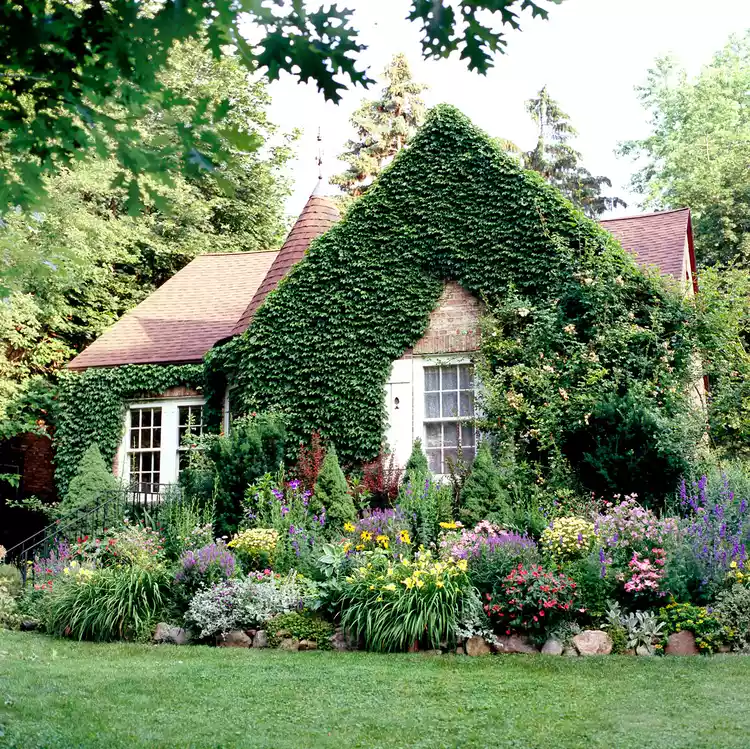Why an English Cottage Garden Might Be the Secret to Better Curb Appeal

Charming and continually blooming in popularity, the English cottage garden aesthetic is marked by billowy ornamental grasses, jumbled perennials and shrubs, and hardscapes clustered in a way that make it seem like the roses are taking over.
Looking at these near-wild gardens, you might not realize that it takes careful planning and regular upkeep to maintain that carefully careless greenery (even for low-maintenance cottage gardens)—and that time and effort are absolutely necessary if you want your English cottage garden to have any sort of curb appeal. That said, is the English cottage garden trend one that potential buyers will flock to or run from? And can an English cottage garden actually increase curb appeal? Experts say it all has to do with how the garden is planned and grown.
A Surge in Popularity
Yardzen data for 2022 shows that requests for the English cottage garden aesthetic have doubled over the past year.
Yardzen landscape architect Kevin Lenhart has some thoughts on why this look is gaining popularity. Among them is the changing view on the wide green lawn popular in the United States: Some say these lawns limit biodiversity (even if you participate in No Mow May) and can even introduce powerful fertilizers and pollutants from equipment like gas-powered lawn equipment or leaf blowers into the local ecosystem.
"When you think about all the area that lawns occupy across the country, it's an immense missed opportunity to support biodiversity and just to have more aesthetic variety and better expressions of regional landscape character," Lenhart says.
In addition, many homeowners are seeing value in a functional front yard, one that allows for gatherings and interactions with neighbors.
"People are more willing to embrace alternatives to traditional lawns," Lenhart says, which may be a curb appeal point in the English cottage garden's favor.
Landscaping for Curb Appeal
A 2018 paper by the Virginia Cooperative Extension shows that landscape spending significantly increases property value, according to a handful of survey results, and Lenhart says the American Society of Landscape Architects once estimated that resale value increased between 10 and 20% following landscape improvements.
"The caveat is that landscape improvements add value to a house if they are perceived to be kempt and intentional or well-maintained," Lenhart says. "If the neighborhood perceives a landscape to be messy or poorly maintained, that often rankles the neighbors."
Lenhart admits there is some risk involved with a trendy landscape choice like an English cottage garden, but says the key is executing it in a way that makes sense in your region and in your particular neighborhood. When you consider that even a standard lawn can require weekly mowing in the greener months, a well-planted cottage garden can offer more function and less maintenance—and be better for the environment.
"A properly maintained cottage garden is going to look beautiful and would add to the value of your home," he says.
Committing to that maintenance, then, is the key to a good-looking (and buyer-friendly) cottage garden. How you do that is up to you—but our experts have a few tips.
Mastering the Organized Chaos of an English Cottage Garden
Lush and dense, English cottage gardens are a mix of two different looks.
"English and cottage are kind of tributaries that fall under the same umbrella, but they're different," Lenhart says. "Cottage is sort of the more wild, diverse, unkempt version," he says. "English would be more formal. English gardens utilize hedges and crisp, vertical evergreen accents to define spaces and punctuate certain areas."
The original cottage gardens, which Lenhart says began in the 1800s, incorporated fruit trees and aromatic plants out of necessity. Fruit provided food, and rich aromas covered all-too-common unpleasant ones during a time when daily bathing was unheard of.
Lenhart describes English cottage gardens as both forgiving and adaptable, and as something you can replicate in most climates. Many feature foxgloves, hollyhocks, and delphiniums, but Yardzen experts say sage, yarrow, fleabane, buckwheat, lavender, and Russian sage are native species that do well in the drier, western states.
Bobbie Schwartz, a landscape designer with Ohio-based Bobbie's Green Thumb, describes the English cottage garden look as combining formality and informality.
"There is an illusion of it being natural looking," she says. "The antithesis is something that is very formal."
Schwartz has seen more and more homeowners requesting this style for their yards. She has one herself on a lot in Shaker Heights, a Cleveland suburb. Once installed, she says maintenance is minimal. She does the bulk of pruning in spring, dead heading hydrangeas, cutting back roses, and cutting down stalks, then spends a couple hours or so a week poking around to keep things in check.
"It can be very high-maintenance, or lower maintenance depending on plant choices," she says. "But it's a mix. It means you have something that will always be in bloom. The garden will always be changing."
Schwartz keeps a database of the plants in her own yard, including between one and two thousand different species of flowers, shrubs, sedges, groundcover, and grasses. Her yard has some dry spots, a moist spot, and different types of shade.
"It's an inner-city, suburb lot but it's crammed full of plants," she says.
In most cases, Lenhart says you want a big mix of different species, textures, and vertical layers. Plants should be creeping up over any gravel paths, he says, and any kind of seating should be rich with age (so a cottage garden may be the perfect spot for some flea market finds).
"Cottage gardens look like the plants are in charge," Lenhart says.
Ready to boost your own curb appeal with a little organized chaos? You have plenty of cottage-style garden plans at your disposal.